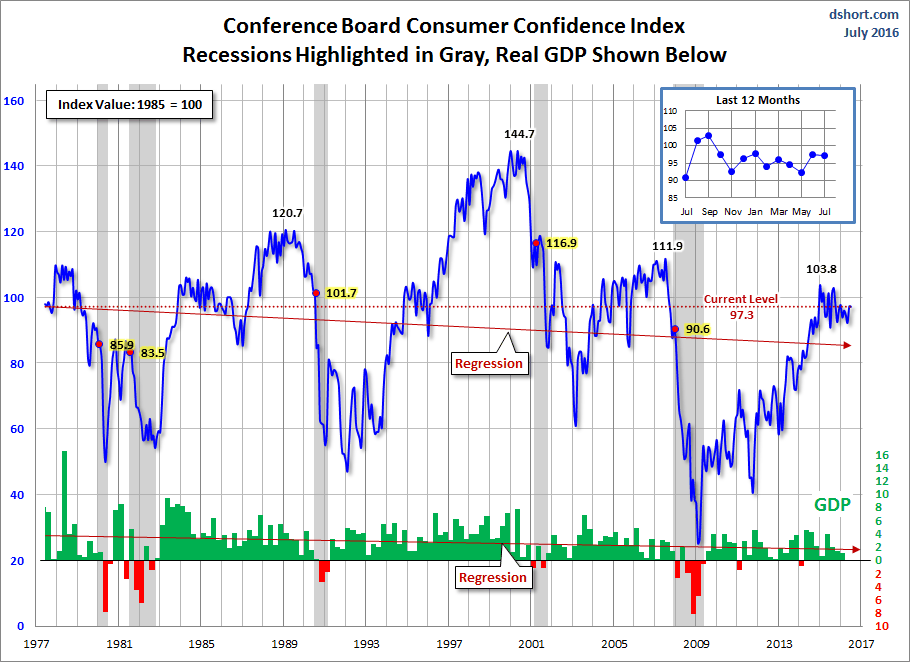Courtesy of Doug Short.
The Latest Conference Board Consumer Confidence Index was released this morning based on data collected through July 17. The headline number of 90.9 was an improvement over the revised June final reading of 86.4, an upward revision from 85.2. Today’s number dramatically beat the Investing.com forecast of 85.3. The current level is the highest since October 2007, the month the S&P 500 peaked prior to the Great Recession.
Here is an excerpt from the Conference Board press release.
Says Lynn Franco, Director of Economic Indicators at The Conference Board: “Consumer confidence increased for the third consecutive month and is now at its highest level since October 2007 (95.2). Strong job growth helped boost consumers’ assessment of current conditions, while brighter short-term outlooks for the economy and jobs, and to a lesser extent personal income, drove the gain in expectations. Recent improvements in consumer confidence, in particular expectations, suggest the recent strengthening in growth is likely to continue into the second half of this year.”
Consumers’ assessment of current conditions improved in July. Those claiming business conditions are “good” edged down to 22.7 percent from 23.4 percent, while those stating business conditions are “bad” was virtually unchanged at 22.7 percent. Consumers’ appraisal of the job market was more favorable. Those saying jobs are “plentiful” increased to 15.9 percent from 14.6 percent, while those claiming jobs are “hard to get” remained unchanged at 30.7 percent.
Consumers’ expectations were more optimistic in July. The percentage of consumers expecting business conditions to improve over the next six months increased to 20.2 percent from 18.4 percent, while those expecting business conditions to worsen held steady at 11.5 percent. Consumers were more positive about the outlook for the labor market. Those anticipating more jobs in the months ahead increased to 19.1 percent from 16.3 percent, while those anticipating fewer jobs declined to 16.4 percent from 18.4 percent. Slightly more consumers expect their incomes to grow, 17.3 percent in July versus 16.7 percent in June, while those expecting a drop in their incomes declined to 11.0 percent from 11.4 percent.
Putting the Latest Number in Context
 Let’s take a step back and put Lynn Franco’s interpretation in a larger perspective. The table here shows the average consumer confidence levels for each of the five recessions during the history of this monthly data series, which dates from June 1977. The latest number has moved 21.5 points above the recession mindset and only 3.3 points below the non-recession average.
Let’s take a step back and put Lynn Franco’s interpretation in a larger perspective. The table here shows the average consumer confidence levels for each of the five recessions during the history of this monthly data series, which dates from June 1977. The latest number has moved 21.5 points above the recession mindset and only 3.3 points below the non-recession average.
The chart below is another attempt to evaluate the historical context for this index as a coincident indicator of the economy. Toward this end I have highlighted recessions and included GDP. The exponential regression through the index data shows the long-term trend and highlights the extreme volatility of this indicator. Statisticians may assign little significance to a regression through this sort of data. But the slope clearly resembles the regression trend for real GDP shown below, and it is a more revealing gauge of relative confidence than the 1985 level of 100 that the Conference Board cites as a point of reference. Today’s reading of 90.9 is well above the current regression point of 78.3.
On a percentile basis, the latest reading is at the 44.9 percentile of all the monthly readings since the start of the monthly data series in June 1977 and at the 39.8 percentile of non-recessionary months.
For an additional perspective on consumer attitudes, see my post on the most recent Reuters/University of Michigan Consumer Sentiment Index. Here is the chart from that post.
And finally, let’s take a look at the correlation between consumer confidence and small business sentiment, the latter by way of the National Federation of Independent Business (NFIB) Small Business Optimism Index. As the chart illustrates, the two have tracked one another fairly closely since the onset of the Financial Crisis.






